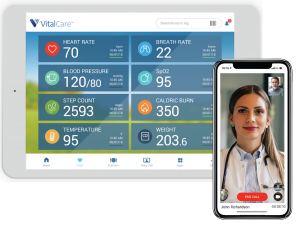Addressing Social Determinants of Health (SDoH) through Functional Design and the Human Touch

Ernie Ianace, EVP of Sales & Marketing, VitalTech® Affiliates, LLC
Inequities in healthcare have long been researched by experts highlighting the disparities in health outcomes among communities of color, the poor, and the medically underserved. We know these disparities are associated with worsening health outcomes for these populations. These inequities have garnered an increasing amount of attention with the emergence of COVID-19 and the undeniable disparities experienced by vulnerable and underserved communities.
VitalTech® is addressing these inequities with their Reach Out Initiative which focuses on improving health literacy and tackles SDoH by integrating the human touch with functional technology design.
Functional Technology Design
The VitalTech virtual care platform, VitalCare®, is designed from the ground up to be the most comprehensive digital care platform in the market. It’s form and function are premised on VitalCare’s ease of use to create a seamless, simple user experience.
- VitalCare’s user interface highlights bright visual colors, large icons and an intuitive user design allowing patients to easily navigate across modules; vital signs, nutrition, medication management, questionnaires, surveys, video calling, messaging, and patient education and engagement tools.
- The platform supports most global languages reducing the impact of health literacy for non-English speaking patients and their families.
- VitalCare offers the most comprehensive Education and Engagement tools. These tools support both the patient and their families. Through a single interface, users can access educational content, emotional support content, how-to instructions and videos, their patient record, their care plan, and any additional content configured by the health system.
- The system’s architecture is built to be flexible and scalable to support 3rd party integrations. One of the most important integrations is to the EHR which links critical health data gathered in the VitalCare platform to the patient record.

The Human Touch
Historically there has been hesitancy within the health community to adopt virtual care as a sustainable care modality. However, with the emergence of COVID-19 we were forced to quickly shift from brick-and-mortar care to virtual care. VitalTech has used this time to examine the impacts of the digital divide and define where the human touch can support the adoption of digital technologies in vulnerable and underserved communities.
- VitalCare Health Navigators support patients and their caregivers every step of the way to achieve the goals of the patient’s care plan. This one-on-one support encourages patients and caregivers to continue on the path to success, while offering emotional support.
- Health systems can create clinical mediated ‘Community Groups’ based on personal interests, recreational activities, disease states, emotional support, social isolation, caregiver support, etc. With this customizable approach, health systems can tailor programs that tackle their most urgent needs, helping to lower overall costs of care.
- Caregiver isolation accounts for a substantial amount of healthcare costs. With the VitalCare Family Connect App, caregivers can receive emotional support and care plan inclusion to better support the patient. Customizable security measures allow caregivers to work with clinicians, case workers, physicians, dieticians and physical therapists. This inclusion lowers the fears and anxieties caregivers often face when caring for their loved ones at home.
- Technical support is key to VitalCare’s virtual care strategy. This seemingly simple step can cause a patient’s program to be unsuccessful before it begins. Technical support must be able to easily troubleshoot broadband issues, address mobile and medical device inexperience, and support language and reading barriers along with many other gaps in health literacy.
Broadband Access
The American Medical Informatics Association (AMIA) identified broadband is a key social determinant of health in 2017. VitalTech has strategically selected AT&T’s FirstNet as their broadband network provider for their virtual care solution, VitalCare. FirstNet, a federally mandated broadband network, provides 24/7 priority access to data, expands available coverage areas and hosts end-to-end data encryption for additional safety and security. With the FirstNet network, VitalTech is able to provide its virtual care solution to patients and caregivers without the possibility of environmental disruptions in service.
As healthcare continues to adapt technologies that bridge the gap in the digital divide, VitalTech is on the headwinds of advancement in both technical and human design. VitalTech and their partners are working together to solve previously unsolvable virtual care issues. The latest developments in functional technology design and reliable broadband access allow health systems to better support vulnerable and underserved communities through human touch.
If you would like to learn more about partnering with VitalTech to tackle SDoH, contact info@vitaltech.com or visit vitaltech.com.
About the Author:
Ernie Ianace is the Executive Vice President of Sales and Marketing at VitalTech® Affiliates, LLC. Based in Plano, TX, VitalTech is a rapidly growing provider of fully integrated digital health solutions and smart biomedical wearables that provide real-time monitoring for patient wellness and safety. The company’s connected care platform, VitalCare®, enables health systems, skilled nursing facilities, home health providers, physicians, and senior living facilities to streamline workflows while improving health outcomes, increasing patient safety, and lowering the cost of care.

